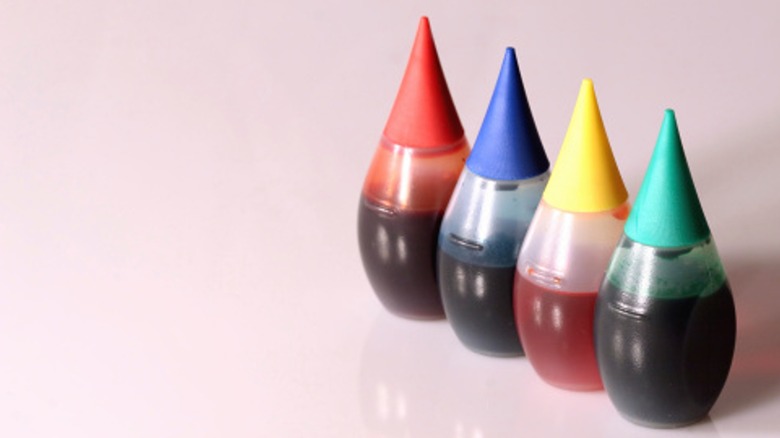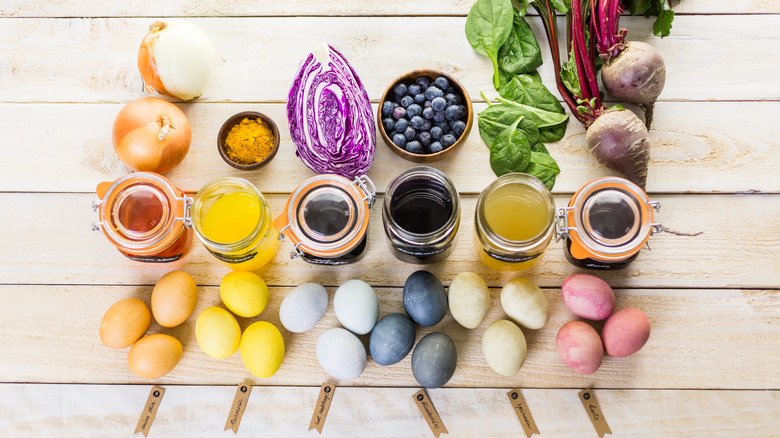The Ingredients That Make Up Artificial Food Coloring
Artificial food coloring is one of the most controversial ingredients widely used in American food products, including snacks, drinks, candy, and even vitamins. Some consumers are simply wary of any ingredients not considered "natural," but on the scientific side, studies have tried to prove a correlation between the consumption of food dyes and negative effects on the general population. These concerns range from the presence of carcinogens (as in a 2012 study in the National Library of Medicine) to hyperactivity in children (including data compiled by the California Office of Environmental Health Hazard Assessment).
While proof that food dyes cause cancer or certain child behaviors is generally inconclusive, you might wonder what these colorings are made of, and how that contributes to their bad rap. Most food colorings in the U.S. are derived from petroleum, though the FDA requires vigorous testing and batch certification to ensure no traces of petroleum remain in the final product. The finished colorings wind up as some mixture of carbon, hydrogen, iodine, oxygen, sodium, and sulfur, all of which are common in natural foods and safe to consume in small amounts.
This isn't to say that all food dyes behave the same. Depending on the product they produce, manufacturers choose between four different categories of colorings: azo, xanthene, triphenylmethane, and indigoid. For instance, xanthene dyes are commonly used in candy, drinks, and cake-decorating supplies due to their high solubility in liquids. They dissolve seamlessly into cherry soda, red velvet cake mix, and more.
Some researchers attribute negative health effects to food dyes
Although the ingredients used in artificial food colorings are safe individually, some have concerns about how these ingredients interact with each other. Many food dyes contain the preservative sodium benzoate, and according to Healthline, prolonged exposure to heat and light can transform sodium benzoate into benzene, a known carcinogen. Additionally, the dyes Red 40, Blue 1, Yellow 5, and Yellow 6 seemingly cause hypersensitivity in certain consumers, and Red 3 can cancer in animals.
A 2015 Nielsen survey found that 42% of global respondents had concerns about artificial food dyes (via Industry Dive). Consumers around the world have pushed for food and drink companies to use naturally-derived colorings more often. Big brands like General Mills have axed artificial dyes in certain products, but many corporations have found that natural dyes don't produce results as consistent or vibrant as those of artificial dyes, making the move harder to pull off.
At the end of the day, it's important to remember that food dyes used in America are subjected to the same level of scrutiny as any other product approved by the FDA. The organization has strict regulations regarding how dyes can be used and labeled, and manufacturers can only use them in amounts that are deemed safe for the general public. Of course, you can also make the personal decision to avoid artificial dyes entirely.
What ingredients are used in natural food dyes?
If artificial food coloring is made with petroleum-derived ingredients, what goes into natural food dyes? The exact ingredients differ from one product to the next, but most naturally-derived colorings come from one of three sources: plants, minerals, and bugs. Sounds yummier than crude oil, we suppose.
Carminic acid, a popular natural dye used to color foods red or pink, is actually made from ground-up cochineal bugs. Other red dyes can be made from paprika, beets, or pomegranate juice — much easier to use to naturally color foods at home (try making red velvet cake without dye by using beetroot powder). Yellow dyes are typically made with turmeric or saffron, while blue dyes can be made from boiling down red cabbage. You can also naturally dye foods green with spinach or purple with any berries containing anthocyanin, such as blueberries or blackberries.
Although plant- and insect-derived dyes can produce dull or inconsistent results, minerals can create more stable colorings. Titanium dioxide and calcium carbonate, for instance, are used to give foods a bright white color, while iron oxides can create red or yellow colorings in some applications. However, just like artificial food coloring, natural dyes can cause allergic reactions in certain individuals, so it's always a good idea to know your sensitivities and read the labels on your food.



